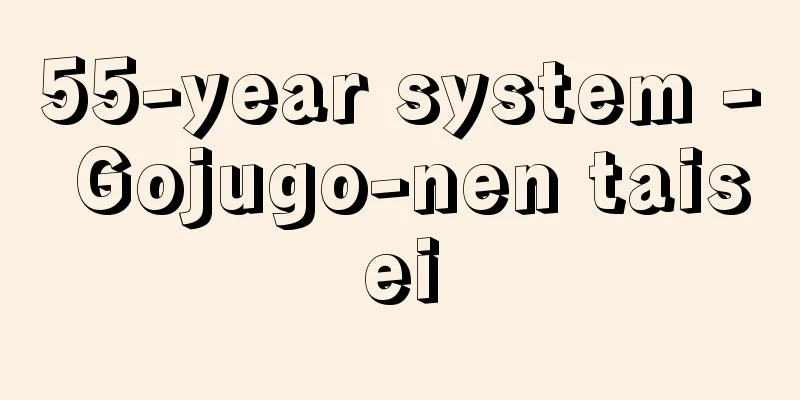55-year system - Gojugo-nen taisei

|
A system of party politics centered on the two major parties, the Liberal Democratic Party and the Japan Socialist Party, which began in 1955. When the Japan Socialist Party, which had been divided into left and right, unified in 1955, the conservative camp was inspired to merge the Liberal Party and the Japan Democratic Party to form the Liberal Democratic Party. Since then, the 55-year system has lasted for 38 years. It is mainly defined by the following two elements. (1) Conservative-Progressive Conflict: The conservative forces (→Conservative parties) who valued relations with Western countries, especially the United States, and maintained the Japan-US Security Treaty (→Japan-US Security Treaty), revised the Constitution, and pursued traditional values, on the one hand, and the progressive forces (→Progressive parties) who valued relations with socialist countries (→Socialism), opposed the Japan-US Security Treaty, and advocated the protection of the Japanese Constitution and modern democratic values (→Progressive parties); (2) One-or-Half Party System: At first, it seemed as if a two-party system with the possibility of a change in government was coming, but in reality, it was a party system in which the Liberal Democratic Party held just under two-thirds of the seats in the House of Representatives, which continued until 1993. The LDP government was unable to deal with financial scandals such as the Lockheed scandal in 1976, the Recruit scandal in the 1980s, and the Tokyo Sagawa Kyubin scandal in 1992, and lost its majority in the general election of the House of Representatives in July 1993, and the Japan Socialist Party also suffered a crushing defeat. Meanwhile, the Japan New Party, the Renewal Party, and the New Party Sakigake increased their vote numbers, and the following August these new party groups, along with the Japan Socialist Party, the Democratic Socialist Party, and the Komeito Party, formed the Hosokawa coalition cabinet, thus bringing the 55-year system to its knees. Source: Encyclopaedia Britannica Concise Encyclopedia About Encyclopaedia Britannica Concise Encyclopedia Information |
|
1955年に始まる,自由民主党と日本社会党の二大政党を中心とした政党政治運営の仕組み。左右に分裂していた日本社会党が 1955年に統一を果たすと,これに触発された保守陣営では,自由党と日本民主党の保守合同により自由民主党が誕生した。以後,55年体制は 38年間続いた。おもに以下の二つの要素によって定義される。(1) 保革対立 アメリカ合衆国を中心とする西側諸国との関係を重視し,日米安保体制(→日米安全保障条約)の堅持,憲法改正,伝統的価値を追求する保守勢力(→保守政党)と,社会主義国(→社会主義)との関係を重視し,日米安保体制に反対し,日本国憲法および近代的・民主的価値の擁護を掲げる革新勢力(→革新政党)との対立の構図,(2) 1か2分の1政党制 当初政権交代の可能性を秘めた二大政党制が到来するかにみえたが,実際には 1993年まで続いた,衆議院議席の 3分の2弱を自由民主党が占めるという政党制。自由民主党政権は,1976年のロッキード事件,1980年代のリクルート事件,1992年の東京佐川急便事件と金にまつわるスキャンダルに対処できず,1993年7月の衆議院議員総選挙で過半数割れし,日本社会党も惨敗した。一方,日本新党,新生党,新党さきがけが得票数を伸ばし,翌 8月これら新党グループと日本社会党,民主社会党,公明党が細川連立内閣を樹立,ここに 55年体制は崩れた。
出典 ブリタニカ国際大百科事典 小項目事典ブリタニカ国際大百科事典 小項目事典について 情報 |
<<: Little Ten Group - Kojyunin Gumi
>>: Huzhou Mirror (English: Hu-zhou-jing)
Recommend
Return - Return
〘Self-Ka 4〙 To arrive at the place from which one ...
Hassaku (hassaku orange) - Hassaku orange
A small tree of the Rutaceae family native to Japa...
National interest
It is also called "national interest." ...
Adler, F. - Adler
...Those critical of the Bolsheviks held a confer...
strawberry tomato
… [Tetsuichi Yahara] [Horticultural species] In J...
Son - Son
A play by Osanai Kaoru. One act. Published in Mit...
"Kibun Daijinkuruwa no Irifune" - Kibun Daijinkuruwa no Irifune
...In Kabuki, Sawamura Sojuro III played Kinokuni...
Hanasaki crab - Hanasaki crab
A marine animal belonging to the order Decapoda, ...
Alumina cutting tools - Alumina cutting tools
…A typical example is alumina Al 2 O 3 , sintered...
Tankai
A collection of essays from the late Edo period wr...
Aruri - Aruri
…The oldest carvings, of elephants and hippos, ar...
Orchestia ochotensis (English spelling) Orchestiaochotensis
…[Shigeo Gamou]. … *Some of the terminology that ...
Jim Crowism
…Jim Crow as a law was abolished with the passage...
Gasho
...There are dongxiao of various lengths, but unl...
Gansa Jongko - Gansa Jongko
...In large-scale gamelan ensembles in Central Ja...









